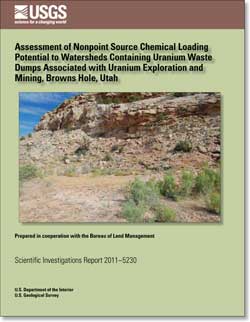 Abstract
Abstract
During August of 2008, 35 solid-phase samples were collected from abandoned uranium waste dumps, undisturbed geologic background sites, and adjacent streambeds in Browns Hole in southeastern Utah. The objectives of this sampling program were (1) to assess impacts on human health due to exposure to radium, uranium, and thorium during recreational activities on and around uranium waste dumps on Bureau of Land Management lands; (2) to compare concentrations of trace elements associated with mine waste dumps to natural background concentrations; (3) to assess the nonpoint source chemical loading potential to ephemeral and perennial watersheds from uranium waste dumps; and (4) to assess contamination from waste dumps to the local perennial stream water in Muleshoe Creek. Uranium waste dump samples were collected using solid-phase sampling protocols. Solid samples were digested and analyzed for major and trace elements. Analytical values for radium and uranium in digested samples were compared to multiple soil screening levels developed from annual dosage calculations in accordance with the Comprehensive Environmental Response, Compensation, and Liability Act’s minimum cleanup guidelines for uranium waste sites. Three occupancy durations for sites were considered: 4.6 days per year, 7.0 days per year, and 14.0 days per year. None of the sites exceeded the radium soil screening level of 96 picocuries per gram, corresponding to a 4.6 days per year exposure. Two sites exceeded the radium soil screening level of 66 picocuries per gram, corresponding to a 7.0 days per year exposure. Seven sites exceeded the radium soil screening level of 33 picocuries per gram, corresponding to a 14.0 days per year exposure. A perennial stream that flows next to the toe of a uranium waste dump was sampled, analyzed for major and trace elements, and compared with existing aquatic-life and drinking-water-quality standards. None of the water-quality standards were exceeded in the stream samples.
|
First posted March 14, 2012
Part or all of this report is presented in Portable Document Format (PDF); the latest version of Adobe Reader or similar software is required to view it. Download the latest version of Adobe Reader, free of charge. |